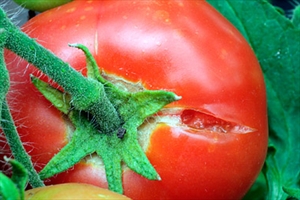Tomato fruit slitting, tomato fruit cracking
Pacific Pests, Pathogens and Weeds - Online edition
Pacific Pests, Pathogens & Weeds
Tomato fruit splitting (164)
This is not a disease; it is a physiological disorder.
Probably, in all countries where tomato is grown.
Tomato
Fruit splitting is not a disease; it is a physiological problem, caused by the growing conditions. Splits occur in the fruits (Photos 1&2) when the water supply fluctuates or because the temperatures rises and falls irregularly. The cracks and splits allow entry of bacteria, fungi and other organisms, and rots occur.
Splits are most likely when sudden heavy rains follow dry spells. There are different opinions about what happens. One suggestion is that cracks start during dry times and then, when heavy rains occur and water arrives suddenly, the fruits fill with water and burst at the cracks. Another possibility is that with a sudden amount of rain the inside of the fruit grows faster than the skin and cracks occur. It usually happens when the fruit are close to ripening, as the skin is more fragile at that time.
Tomato fruits commonly split, but it is not clear how important this is. However, as it is a problem caused by fluctuating temperatures and water supplies, and that occurs in most countries where the crop is grown, it is likely to account for significant losses.
Look for the splits and cracks of all kinds.
CULTURAL CONTROL
There is a limit to how much growers can do to control environmental forces when tomatoes are grown in the field. However, it might help to do the following:
Before planting:
- Add well-rotted manure, compost or commercial fertilizer to the soil to ensure healthy plant growth. Apply them at planting and again when the fruits are set.
During growth:
- Water plants regularly in dry times and when there is not enough rain. If crops can be irrigated using drip or overhead systems, this will bring an obvious advantage.
- Use a thick mulch (5-8 cm) of dried grass or other leaves to prevent water loss from the soil in dry times and to keep the soil moist. Wood chips and plastic can also be used as mulches.
- Harvest the fruit as soon as possible. If splitting occurs, harvest unripe fruit and ripen them in a warm dark place.
- Do not over-fertilize, and if splitting occurs try reducing the amount of nitrogen in the next crop.
RESISTANT VARIETIES
Beefstake varieties are said to be more susceptible to fruit splitting, so try different kinds, especially those that have thick skins. Varieties that have been bred in more recent years are less susceptible to splitting.
CHEMICAL CONTROL
Not a method of control for this disorder.
AUTHOR Grahame Jackson
Information from NC Cooperative Extension (2020) What causes tomatoes to crack? (https://pender.ces.ncsu.edu/2020/03/what-causes-tomatoes-to-crack/). Photo 1 Royal Society of Horticulture. (http://rhs.org.uk/advice/profile?PID=393).
Produced with support from the Australian Centre for International Agricultural Research under project PC/2010/090: Strengthening integrated crop management research in the Pacific Islands in support of sustainable intensification of high-value crop production, implemented by the University of Queensland and the Secretariat of the Pacific Community.





